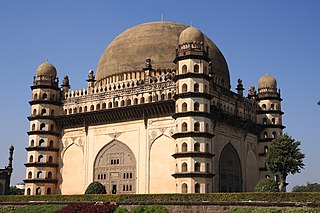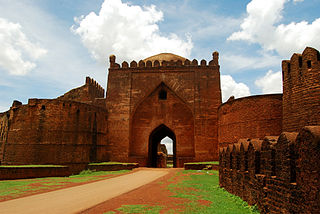| |||||
| Centuries: | |||||
|---|---|---|---|---|---|
| Decades: | |||||
| See also: | List of years in India Timeline of Indian history | ||||
Events from the year 1534 in India.
| |||||
| Centuries: | |||||
|---|---|---|---|---|---|
| Decades: | |||||
| See also: | List of years in India Timeline of Indian history | ||||
Events from the year 1534 in India.

The Deccan sultanates were five late-medieval Indian kingdoms—on the Deccan Plateau between the Krishna River and the Vindhya Range—that were ruled by Muslim dynasties: namely Ahmadnagar, Berar, Bidar, Bijapur, and Golconda. The sultanates had become independent during the break-up of the Bahmani Sultanate. The five sultanates owed their existence to the declaration of independence of Ahmadnagar in 1490, followed by Bijapur and Berar in the same year. Golconda became independent in 1518, and Bidar in 1528.

Gol Gumbaz, also written Gol Gumbad, is a 17th-century mausoleum located in Bijapur, a city in Karnataka, India. It houses the remains of Mohammad Adil Shah, seventh sultan of the Adil Shahi dynasty, and some of his relatives. Begun in the mid-17th century, the structure never reached completion. The mausoleum is notable for its scale and exceptionally large dome.

Krishnadevaraya was an emperor of the Vijayanagara Empire reigning from 1509 to 1529. He was the third monarch of the Tuluva dynasty, and is considered to be one of the greatest rulers in Indian history. He ruled the largest empire in India after the fall of the Islamic Delhi Sultanate. Presiding over the empire at its zenith, he is regarded as an icon by many Indians. Krishnadevaraya earned the titles Andhra Bhoja, Karnatakaratna Simhasanadeeshwara, Yavana Rajya Pratistapanacharya, Kannada Rajya Rama Ramana, Gaubrahmana Pratipalaka and Mooru Rayara Ganda. He became the dominant ruler of the peninsula by defeating the sultans of Bijapur, Golconda, the Bahmani Sultanate and the Gajapatis of Odisha, and was one of the most powerful Hindu rulers in India.

The Adil Shahi or Adilshahi, was a Shia, and later Sunni Muslim, dynasty founded by Yusuf Adil Shah, that ruled the Sultanate of Bijapur, centred on present-day Bijapur district, Karnataka in India, in the Western area of the Deccan region of Southern India from 1489 to 1686. Bijapur had been a province of the Bahmani Sultanate (1347–1518), before its political decline in the last quarter of the 15th century and eventual break-up in 1518. The Bijapur Sultanate was absorbed into the Mughal Empire on 12 September 1686, after its conquest by the Emperor Aurangzeb.

Ibrahim Adil Shah II was king of the Sultanate of Bijapur and a member of the Adil Shahi dynasty. Under his reign the dynasty had its greatest period as he extended its frontier as far south as Mysore. He was a skilful administrator, artist, poet and a generous patron of the arts. He reverted to the Sunni orthodoxy of Islam, but remained tolerant of other religions, including Christianity. However, during his reign high-ranking Shiite immigrants became unwelcome and in 1590, he ordered the confinement of criers who read the khutba in the Shia form. After his reign, increasing weakness permitted Mughal encroachment and the successful revolt of the Maratha king Shivaji, who killed the Bijapur general Afzal Khan and scattered his army. The dynasty left a tradition of cosmopolitan culture and artistic patronage whose architectural remains are to be seen in the capital city of Bijapur.
Firishta or Ferešte, full name Muhammad Qasim Hindu Shah Astarabadi, was a Persian historian, who later settled in India and served the Deccan Sultans as their court historian. He was born in 1570 and died in 1620. The name Firishta means 'angel' in Persian.

Yusuf Adil Shah (1450–1510), referred as Adil Khan or Hidalcão by the Portuguese, was the founder of the Adil Shahi dynasty that ruled the Sultanate of Bijapur for nearly two centuries. As the founder of the newly formed Bijapur dynasty, Yusuf Adil Shah is credited with developing the town of Bijapur and elevating it to significant status.
Ismail Adil Shah was the king of Bijapur who spent most of his time extending his territory. His short-lived reign helped the dynasty establish a stronghold in the Deccan.
Mallu Adil Shah, of the Adil Shahi dynasty, was the king of the Bijapur Sultanate of modern-day southern India. He ruled for a short period in 1534, before being deposed and blinded.

The Battle of Raichur was a battle fought between the Vijayanagara Empire and the Sultanate of Bijapur in 1520 in the town of Raichur, India. It resulted in a decisive victory for Vijayanagara forces, and the Bijapur ruler was defeated and pushed across the river Krishna.

The Jama Masjid of Bijapur is a congregational mosque in the Indian state of Karnataka. Initiated by Ali Adil Shah I of the Bijapur Sultanate in the 16th century, the mosque was never completed. It is the largest mosque in Bijapur, and has a capacity of 4000 worshippers.
Ibrahim Adil Shah I was a Sultan and later Shah of the Indian kingdom of Bijapur. He succeeded his elder brother, Mallu Adil Shah, through the machinations of the Afaqi faction at the court. He was the first Adil Shahi ruler to assume the royal title of Shah.
Events in the year 1556 in India.

The Bijapur Fort is located in the Bijapur city in Bijapur District of the Indian state of Karnataka. Bijapur fort has a plethora of historical monuments of architectural importance built during the rule of Adil Shahi dynasty.
Events from the year 1510 in India.
This is list of events in India in year 1627.
Events from the year 1590 in India.
Events from the year 1558 in India.

Deccani Architecture refers to the architectural styles developed during the Deccan sultanate period. The Deccan sultanates were five dynasties that ruled late medieval kingdoms, namely, Bijapur, Golkonda, Ahmadnagar, Bidar, and Berar in south-western India. The Deccan sultanates were located on the Deccan Plateau. Their architecture was a regional variant of Indo-Islamic architecture, heavily influenced by the styles of the Delhi Sultanate and later Mughal architecture, but sometimes also directly from Persia and Central Asia.
Adil is an Arabic masculine given name and surname. Adil is a variation of the name Adel, an Arabic male name that comes from the word Adl, meaning "fairness" and "justice". It is a common name in the Muslim world.